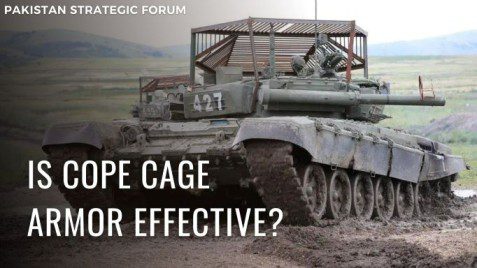In the Russian attempt in Ukraine to secure its interests, a fraction of tanks has been seen with cage armor on their turret tops, varying in design from an overall structure to the element shapes. Apparently, the additional armor is increasing the probability of survival of T-72, T-80s and T-90s against the modern Javelin ATGMs, received by Ukrainian military in early days of war. The US made Javelin is unconventional anti-tank missiles, which can be used in two modes, the top attack and direct. The latter is quite common and tanks are purposely built to be strong on the turret front, upper and lower hull, and at times the side skirts as well, when urban warfare or open lands provides the chances to hit the tank from side as well. These areas are heavily armed with HRA (Homogenously Rolled Armor) steel with additional Composites, NERA (Non-explosive Reactive Armor), Spaced Armor Plates or ERA (Explosive Reactive Armor). But the top of the tank is often least thick and often lack any additional covering. Though the top is added with a few bricks of ERAs occasionally, it’s in general not a practice to reinforce it as it will add more weight and increase the production cost of a standard tank. Since the Russian tanks are vulnerable to Javelins, and ERA is fractionally effective against shaped dual charges, metal cages have been implanted on those tanks. But, are they really effective?
According to the studies conducted by the company manufacturing Cope Cage Armor for Russian tanks and armored vehicles, the cages are effective against RPGs and shaped charges, as they shear away the impacting round and the rest of the armor bears the impact effectively. Due to which, T-90M, T-14 Armata and other modern Russian vehicles have been witnessed with cage armor on the side skirts and rear. But not all cages are effective, because there is a whole engineering design process behind the evident cage designs of T-90Ms and T-14s. The metal rods and bars placed in a fixed proportion has a secret in it. According to the study, the most effective cage armor is the one having the metal bar elements of 10mm diameter, and spacing of 80mm in between their edges, as evident from the provided picture. This will work most effectively, by reducing the significant 65% impact of the incoming round and shearing the shaped round, increasing the area of contact, which will distribute the impulse force around and eventually the tank has a chance to survive.

But Russian tanks witnessed with different cage designs are telling another story. Most commonly, they have used angles beams, welded together in custom designs and shapes, with random distancing between the bars oriented in different configurations with random distancing between them. They even vary in their heights, in some cases, making it difficult for the crew to flee away after receiving a hit. Other examples consist of rods, placed at a nominal distance, closer to the originally designed cage, which may be effective. But it’s certain that the Russians came poorly prepared for it, and only a fraction of tanks have been seen with those cages, with a few of them destroyed as well from direct attacks, since Ukraine has a couple of different ATGMs, with the Skif/Stunga-P being the modern indigenous weapon system. So far, any Javelin destroying a tank with cope caged armor has not been witnessed, and the curiosity remains that how a cheap solution will behave against the expensive 178,000 Dollars Javelin ATGM.
Credits: Red Effect
#StingRay
#TeamPakistanStrategicForum







